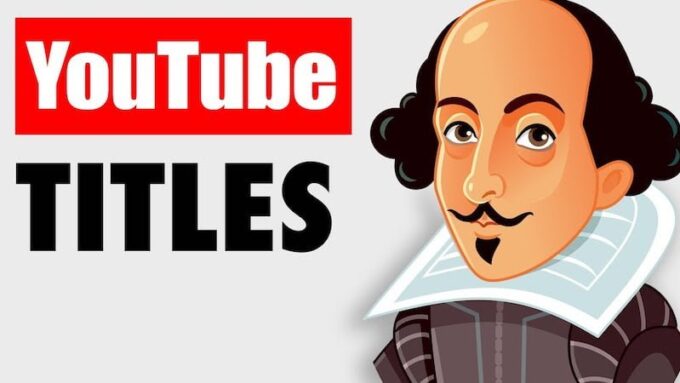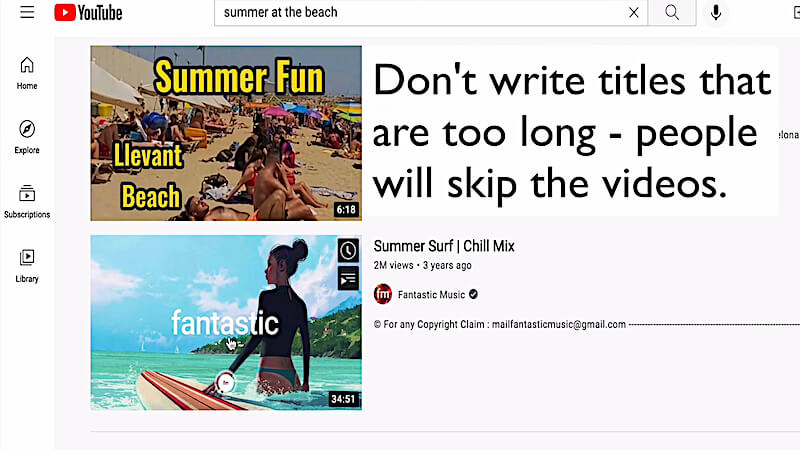Last updated on June 5th, 2024
THE GOAL
In this video I’m going to show you how to write good titles for your YouTube videos. And this is so important because if the title isn’t interesting, your customers may never click on your videos and you’ll get zero views. But today I’m going to show you how, and I’ve given you more info in the description below.
HERE’S THE PROBLEM
The title of your YouTube video is one of the most important parts of any YouTube video, but a ton of businesses get this wrong. And it’s important to remember that when you’re doing it right, the title, the topic, and the YouTube thumbnail work together as a team to get the right person to click to watch your video. Nobody’s going to click just because – ta-da – you released a new video. Good for you but you won’t get views if nobody clicks. And the fewer people who click the worse YouTube will start to rank your videos and overall channel so that eventually nobody is watching it all! But that’s a bit doom and gloom, and hopefully it doesn’t get that bad. It’s OK, you got this! If I can do it you can do it.
THE STEPS
Here’s the steps.
- STEP 1: TITLES, TOPICS, AND THUMBNAILS GO TOGETHER
I can’t stress enough how important it is that your YouTube title, topic and thumbnail work together as a team. If they aren’t good by themselves, and if they don’t play well with each other, then you’re going to lose out.
For example: Let’s say I’m making a movie poster for my science fiction movie. The topic is, say, a battle between good and evil in space, and the movie has lots of planets struggling for freedom, and heroes, and lasers, and love stories, and spaceships. OK that’s the topic. The poster (or in this case, the YouTube thumbnail), is going to have some of those visual elements and look and feel so you know in a second whether it’s a movie you want to see or not. But what do you call the movie? That’s our YouTube title. How about something like: “Dark Star Rising”? That seems pretty good. Of course, I just described “The Empire Strikes Back,” and that title’s pretty good, too.
- STEP 2: USE WORDS LIKE “HOW TO”
We believe that your customers are coming to YouTube looking to learn how to do things to make their lives easier or do their jobs better. And using the words “How To,” “Tips,” “Tutorial,” “Hack(s),” something “Vs” something else – these are words that signify that a problem needs to be solved, and we recommend putting them in a title when possible.
But don’t take my word for it, look at Google Trends. When you toggle by web searches, which is Google, people are searching for “what” questions a little bit more than “how to” And all other types of questions (why, when, which, who and others) are much lower. But if you do the same search by toggling for YouTube vs. Google, “how-to” beats out “what” and the other types of questions by far!
What this tells us is that using “How To” or other “how-to-like” words like tips, tutorial, and hacks can get you more clicks.
- STEP 3: BE ACCURATE YET ENTICING
You don’t want to be deceptive in your YouTube videos titles – you want to be accurate but enticing. For instance, you don’t want the title of your how-to video to be “Summer at the Beach” if it’s really about life insurance, even if you think “Summer at the Beach” will get more clicks. Why is this? Because people will click on it and then when they realize it’s about a different topic, they’re going to click off fast. And this short view duration makes YouTube rank the video very low. And also you’ve sort of betrayed the trust of your viewer and they probably won’t want to watch your other videos.
And remember – even if you have a product or service that some people think is boring – for the person who has that problem right now and is trying to solve it, you’ve got the most interesting video in the world. The other people who think it’s boring – they don’t matter. Because they weren’t your audience to begin with.
But you can also use more enticing language. So instead of something like “How To Hammer A Nail” you might say “How To Hammer A Nail [Save Your Thumbs]”
- STEP 4: BE BRIEF
If it takes too long a title to describe your video, I’m sorry to tell you, you’ve probably got a bad video. This topic might be better as a long blog post instead. I’d say that 3-7 words is probably the sweet spot for a title. And here’s why:
- You’ve only got about a fifth of a second for people to decide whether to click on your video or not. The viewer is also looking at the same time at a lot of other videos right next to yours to decide which one to click. A title that’s too long is confusing because it just takes too long to read.
- Most YouTube viewers are on mobile. And in some places on the YouTube mobile app, only the first 2-3 words of a title are visible. And in most places on mobile, only about 35 characters are visible. So keep it brief.

- STEP 5: GET THE PHRASE RIGHT
OK so you know the general words you’re looking for, but how do you arrange them? This can be really important.
For example: I was writing a tutorial about how to verify your YouTube channel. But there were some other variations on possible language, like how to validate your YouTube channel, and sometimes they called it a YouTube account instead of a YouTube channel. But it was important to get it right, because YouTube confusingly has two very similar names for getting verified – one was for big channels, and one was for new channels. Also, people might be searching for one of these when they really want the other. So you have to get in the mind of your viewer a bit. I ended up going with “How To VERIFY A YouTube Account” as the title but I actually put “Verify YouTube Channel” in the title. So I sort of did both.
But basically, try to be the thing you would click on if you were trying to solve the problem in your video. You might even try re-arranging the title, particularly if it’s a longer one. For instance, instead of “How to Make Chicken Soup with Grandma’s Recipe”, you might do “Chicken Soup [Grandma’s Recipe] – How To Make It?”
To find the right phrasing, one of the easiest ways to start is by using the “autocomplete” in YouTube search. So you just type in your main phrase and see what comes up after it automatically. You can also do what I call the “underscore” search, where you do an underscore, space, and then the phrase. This tells you the most popular overall phrases with your keyword phrase. And Google has the “People also ask” section which will tell you the most popular related questions.
And there are great paid tools that help you up your game here, and I have affiliate links in the description. The TubeBuddy Keyword Explorer gives you a ton of info about how you’ll do in competition with other channels for this phrase, when are people most interested in it, and more. VidIQ will tell you about how many searches there are for that phrase, and Morningfame will tell you which phrases do better for larger or smaller channels.
- STEP 6: NARROW IT DOWN
Sometimes if you use too broad a title it will get lost in the shuffle. But if you are more specific, you can win the day and also focus on your target audience. For instance, “How To Use Your iPhone” is going to have a lot of competition. But “How To Use The iPhone For Realtors” might do a lot better.
- STEP 7: THINK OF YOUR AUDIENCE
Even if some titles might be more popular, they might not be as relevant to your viewers. For instance, Americans spell the word “Practice” with a “ce” at the end, but in many other English speaking countries they might spell it with an “se” at the end. So if you’re targeting a US audience, spell it with a “ce.” Also if you’re targeting an expert in a field, go ahead and use expert words. You may not get as many views, but they will be more valuable viewers and respond better to your videos.
- STEP 8: CAPITALIZE SOME WORDS
I usually CAPITALIZE certain words to make them stand out in a title. So for this tutorial which is about “YouTube video titles” I might capitalize “TITLES” or both “YOUTUBE” and “TITLES.”
YouTube Creators Insider says don’t do it, and certainly don’t do ALL CAPS ON EVERY WORD IN THE TITLE. https://youtu.be/EboXvfzcwc0?t=163 (2:29 in) But I think if you use it sparingly, it’s OK!
- STEP 9: CONSIDER EMOJIS
Emojis are eye-catching, they’re friendly, and sometimes you can find one that either makes it easy to represent your company that you use in every video. For instance, on one channel we managed, we used a heart emoji ❤️ in every title [https://www.youtube.com/c/ShopJustice/videos]. Or if you’re a financial institution and emojis like a heart are too cutesy for you, you might use an emoji like an increasing chart 📈, or a dollar bill 💵, or an emoji that looks like a bank building (🏦 or 🏛️).
Generally I would use the emojis at the end or middle of the title rather than at the beginning.
- STEP 10: CONSIDER BRACKETS [REALLY]
If you’re writing a longer headline, consider using a bracket at the end. According to a study by Hubspot:
“Headlines with bracketed clarifications (e.g., [photos], [interview], … , [slideshow], etc.) performed 38% better than headlines without clarifications, suggesting readers are more likely to click when they have a clear picture of what lies behind the headline.”
Some people also use the “pipe” (this thing: | ) as a separator in titles.
- STEP 11: DON’T USE “AND”
You should almost never use the word “AND” in your titles. It usually makes the titles too long to read quickly and just makes them too confusing, and that stops you from getting clicks. If you find yourself having to use the word “and” in your title, that’s a hint that you’ve really probably got at least two videos in there. But a video should really only be about one topic, not two.
TODAY IS YOUR DAY!
My name is Dane Golden from the Video Marketing Business Academy and TODAY IS THE DAY for you to start upping your game on YouTube for business so you can transform your viewers into loyal customers. And to begin your journey, just subscribe to our blog and YouTube channel.


